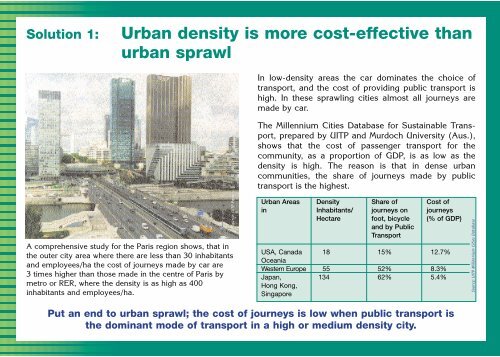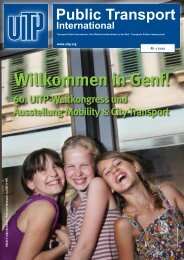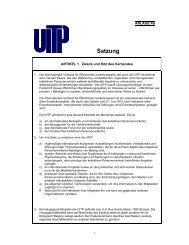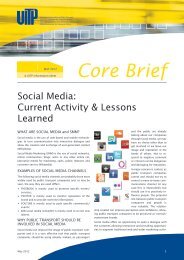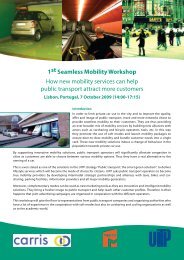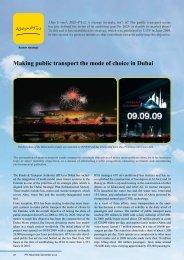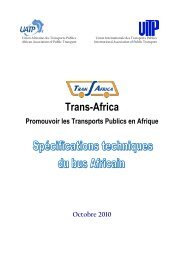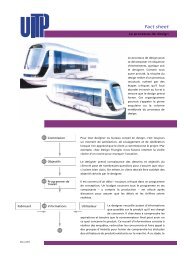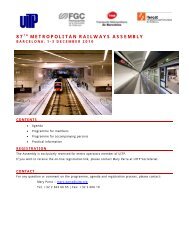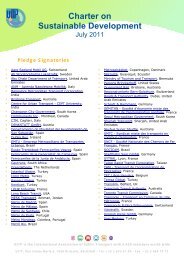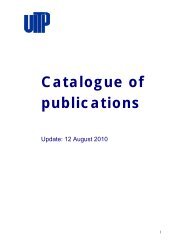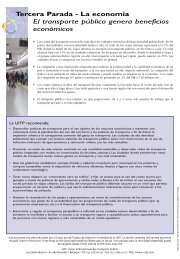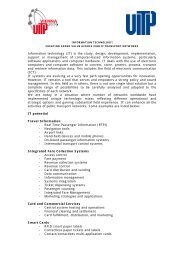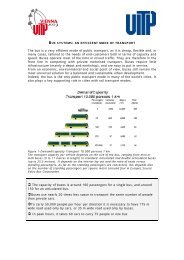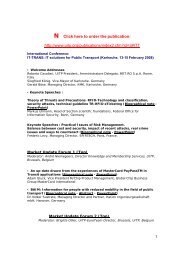Urban density is more cost-effective than urban sprawl - UITP
Urban density is more cost-effective than urban sprawl - UITP
Urban density is more cost-effective than urban sprawl - UITP
Create successful ePaper yourself
Turn your PDF publications into a flip-book with our unique Google optimized e-Paper software.
Solution 1: <strong>Urban</strong> <strong>density</strong> <strong>is</strong> <strong>more</strong> <strong>cost</strong>-<strong>effective</strong> <strong>than</strong><br />
<strong>urban</strong> <strong>sprawl</strong><br />
A comprehensive study for the Par<strong>is</strong> region shows, that in<br />
the outer city area where there are less <strong>than</strong> 30 inhabitants<br />
and employees/ha the <strong>cost</strong> of journeys made by car are<br />
3 times higher <strong>than</strong> those made in the centre of Par<strong>is</strong> by<br />
metro or RER, where the <strong>density</strong> <strong>is</strong> as high as 400<br />
inhabitants and employees/ha.<br />
Source: <strong>UITP</strong> Par<strong>is</strong><br />
In low-<strong>density</strong> areas the car dominates the choice of<br />
transport, and the <strong>cost</strong> of providing public transport <strong>is</strong><br />
high. In these <strong>sprawl</strong>ing cities almost all journeys are<br />
made by car.<br />
The Millennium Cities Database for Sustainable Transport,<br />
prepared by <strong>UITP</strong> and Murdoch University (Aus.),<br />
shows that the <strong>cost</strong> of passenger transport for the<br />
community, as a proportion of GDP, <strong>is</strong> as low as the<br />
<strong>density</strong> <strong>is</strong> high. The reason <strong>is</strong> that in dense <strong>urban</strong><br />
communities, the share of journeys made by public<br />
transport <strong>is</strong> the highest.<br />
<strong>Urban</strong> Areas<br />
in<br />
USA, Canada<br />
Oceania<br />
Western Europe<br />
Japan,<br />
Hong Kong,<br />
Singapore<br />
Density<br />
Inhabitants/<br />
Hectare<br />
Put an end to <strong>urban</strong> <strong>sprawl</strong>; the <strong>cost</strong> of journeys <strong>is</strong> low when public transport <strong>is</strong><br />
the dominant mode of transport in a high or medium <strong>density</strong> city.<br />
18<br />
55<br />
134<br />
Share of<br />
journeys on<br />
foot, bicycle<br />
and by Public<br />
Transport<br />
15%<br />
52%<br />
62%<br />
Cost of<br />
journeys<br />
(% of GDP)<br />
12.7%<br />
8.3%<br />
5.4%<br />
Source: <strong>UITP</strong> Millennium Cities Database
Solution 2: <strong>Urban</strong> development around public<br />
transport stations<br />
Siting offices next to stations reduces walking d<strong>is</strong>tances and<br />
encourages the use of public transport, as can be seen here<br />
in San Diego.<br />
Photo from San Diego CA/USA<br />
Taking public transport into account in <strong>urban</strong> planning<br />
dec<strong>is</strong>ions <strong>is</strong> an <strong>effective</strong> way to stop the increase in<br />
private car traffic and daily traffic congestion. One of the<br />
best incentives for leaving the car at home <strong>is</strong> a short<br />
walk to an attractive public transport station.<br />
The graph below, from a small town in Switzerland,<br />
shows that the number of public transport users <strong>is</strong><br />
doubled when the walking d<strong>is</strong>tance to the nearest stop <strong>is</strong><br />
reduced from 7 minutes to 2 minutes.<br />
Public transport stops should be no <strong>more</strong> <strong>than</strong> a short walk from home<br />
and as close as the parking lot to the office.<br />
Modal-split (%)<br />
Walking d<strong>is</strong>tance in min.
Solution 3: Cities become welcoming and dynamic<br />
when freed from congestion<br />
60 Italian cities, such as Bologna, have closed their centres<br />
to general traffic, allowing only buses and delivery vehicles<br />
at certain times.<br />
Source: Bologna<br />
It <strong>is</strong> not the purpose of city centres to attract cars, but to<br />
attract residents, shoppers and v<strong>is</strong>itors for commercial,<br />
cultural or le<strong>is</strong>ure activities.<br />
Concentration of these activities in a small space<br />
imposes strict limits on access in order to preserve a<br />
peaceful environment.<br />
Several cities have been able to keep the attractiveness<br />
of their centres using the following well-known solutions:<br />
• Reduce on-road parking to a minimum.<br />
• Adopt traffic plans that stop through car traffic<br />
except for buses, trams and bicycles.<br />
• Restrict access to the centre by car except for<br />
residents and limited deliveries.<br />
Central areas, liberated from traffic jams and parking,<br />
become available for walking, shopping, and le<strong>is</strong>ure.<br />
Allow public transport access to city centres but restrict other transport.
Solution 4: More trade after pedestrianization<br />
Promoting public transport and creating pedestrian areas<br />
has been successful in Valladolid, Spain.<br />
Source: Peter Schdeigger<br />
Many shopkeepers believe, that parking spaces in front of<br />
their shops are essential for sales. But experience in<br />
many cities shows that converting streets into pedestrian<br />
areas, allowing access only to public transport vehicles<br />
and for deliveries, has increased turnover for local<br />
commerce.<br />
Increase in trade after pedestrian<strong>is</strong>ation (%)<br />
International experience shows that pedestrian-friendly areas,<br />
with attractive public transport access gives shops a boost.
Solution 5: Strict parking policies in city centres<br />
reduces traffic jams<br />
Pedestrianization of a city road (as seen here in Lüneburg<br />
Germany) enhances local trade, despite the loss of parking<br />
spaces.<br />
Source: <strong>UITP</strong><br />
Contrary to popular belief, <strong>more</strong> parking spaces often<br />
means <strong>more</strong> traffic congestion. Restricting the<br />
availability of parking - especially for commuters - <strong>is</strong> the<br />
most <strong>effective</strong> (and cheapest) way to convince drivers to<br />
leave their cars at home. They then change to less<br />
space-consuming modes of transport.<br />
Parking policies are a major tool for successful city<br />
traffic management.<br />
<strong>UITP</strong> recommends the following actions: limit the<br />
creation of parking spaces in new office buildings;<br />
d<strong>is</strong>courage free parking at people’s places of work; limit<br />
parking capacity in centres; optim<strong>is</strong>e parking use<br />
(eliminate on-road parking for commuters through the<br />
use of time restriction ‘blue’ zones…) and ensure that the<br />
restrictions are enforced.<br />
Making <strong>more</strong> parking space available <strong>than</strong> the road network can handle<br />
<strong>is</strong> as illogical as training the muscles of the body<br />
when the heart does not have the appropriate capacity to cope.<br />
PARKING POLICY
Solution 6: Park + Ride complements parking<br />
restrictions in city centres<br />
Park + Ride at a light rail terminal in Hanover (Germany).<br />
Source: GVH<br />
Not everybody lives a short walk from a station, so other<br />
modes need to be used to get to the station. The private<br />
car <strong>is</strong> an important feeder to public transport<br />
interchanges and in many countries Park + Ride facilities<br />
have shown good results getting people to use public<br />
transport to get into the city.<br />
P+R schemes must be cons<strong>is</strong>tent with parking measures<br />
in city centres e.g. each new parking place in a P+R<br />
should mean one parking place in the city centre.<br />
To be attractive, Park + Ride must offer connections to<br />
frequent, fast public transport services and they must be<br />
well managed. Real-time passenger information,<br />
comfortable waiting and transfer areas increase their<br />
attraction.<br />
A car parked in a sub<strong>urban</strong> station means one parking space less in the city<br />
and two car journeys less on the access roads.<br />
PARKING POLICY
Solution 7: Fast, reliable public transport can attract<br />
passengers from other modes<br />
Car drivers, blocked by congestion, see buses and trams<br />
passing and begin to consider a change of mode, as in<br />
Stuttgart, Germany.<br />
Public transport needs to be as fast and reliable as the<br />
private car.<br />
The Metrolink light rail in Manchester has taken 3 million<br />
car journeys off its roads per year.<br />
The growth of traffic in Geneva <strong>is</strong> directly related to<br />
the length of the dedicated bus lanes.<br />
Bus lane (km) Pass. (mi.)<br />
Increasing the speed and reliability of public transport attracts<br />
new passengers, and improves its image.
Solution 8: Give public transport a reserved<br />
right-of-way<br />
Speed and reliability are important factors to make<br />
customers change to public transport. Nice, France has a<br />
dedicated bus lane parallel to the popular beach front.<br />
Space <strong>is</strong> at a premium in <strong>urban</strong> areas so it needs to be<br />
used sensibly. Buses and trams use nearly 20 times less<br />
space to transport the same number of people <strong>than</strong> the<br />
private car.<br />
One of the most <strong>cost</strong> <strong>effective</strong> measures for successful<br />
public transport <strong>is</strong> giving it dedicated rights-of-way.<br />
The resulting increase in speed and reliability:<br />
- Reduces operating <strong>cost</strong>s, mainly through a reduction<br />
in the total number of vehicles needed and fewer spare<br />
vehicles needed to compensate for running late.<br />
- Improves the frequency of the service.<br />
Increasing the vehicle speed and reducing waiting times<br />
results in a shorter overall journey time for passengers.<br />
Giving buses and trams dedicated infrastructure gives a good pay-back<br />
by reducing operating <strong>cost</strong>s and increasing farebox revenue.
Solution 9: Low floor means easy access<br />
Many European cities have low-floor trams and buses<br />
allowing quick and easy boarding to and from the platform<br />
as shown here in Dresden, Germany.<br />
Source:<br />
Easy boarding <strong>is</strong> a must for all sorts of customers:<br />
children, shoppers with heavy bags, parents with<br />
strollers, the elderly. Good accessibility <strong>is</strong> required to<br />
sat<strong>is</strong>fy the needs of those with reduced mobility.<br />
Level boarding <strong>is</strong> a long-time feature of underground<br />
railways. 15 years ago surface vehicles started to have<br />
th<strong>is</strong> type of access and nearly all new buses and light rail<br />
vehicles are now low-floor, offering near level-boarding.<br />
Public transport vehicles are <strong>more</strong> accessible <strong>than</strong> 15 years ago.<br />
ACCESSIBILITY
Solution 10: For heavy traffic demand, metros and<br />
sub<strong>urban</strong> rail are the answer<br />
The large quantity of people travelling by metro in<br />
Singapore keeps the roads <strong>more</strong> clear.<br />
In major cities of the developed world, metros and heavy<br />
rail are the least expensive mode of public transport for<br />
access to and around the city centres.<br />
Although the level of investment in metro, RER or heavy<br />
rail <strong>is</strong> often high, in the long term it offers the most<br />
efficient solution for moving thousands of passengers<br />
during the busy peak hours.<br />
Therefore, the number of metro systems <strong>is</strong> still<br />
increasing in large cities and in the emerging nations,<br />
whose populations are growing fast.<br />
Number of Metros globally 1960-2000<br />
Metros or sub<strong>urban</strong> trains can carry <strong>more</strong> <strong>than</strong> 50,000 passengers<br />
on one line per hour and direction. No other mode can beat that!<br />
25<br />
1960<br />
34<br />
1970<br />
54<br />
1980<br />
74<br />
1990<br />
100<br />
2000
Solution 11: Attractive Interchanges are key to<br />
successful public transport<br />
An interchange in Vancouver Brit<strong>is</strong>h Colombia, Canada<br />
showing the easy transfer between modes.<br />
The larger the city, the <strong>more</strong> passengers have to change<br />
between buses, metros, trams or other modes. Th<strong>is</strong><br />
waste of time can be a great inconvenience, if these<br />
interchanges are not well planned and made attractive.<br />
In good interchange areas, passengers should be able to<br />
use their time in an enjoyable way, to dine and shop for<br />
instance, and these areas can become a dynamic part of<br />
a city.<br />
Public transport interchange<br />
and shopping centre in Sheffield, UK.<br />
Interchanges should not be only used for transport purposes,<br />
but should be developed as interesting and lively parts of a city.
Solution 12: Good passenger information <strong>is</strong> essential<br />
for seamless travel<br />
Dynamic passenger information makes public transport<br />
easier for passengers to use, as can be seen here in West<br />
Yorkshire, UK.<br />
Providing the customer with easy to follow information<br />
on timetables, fares, routes and services makes public<br />
transport <strong>more</strong> accessible.<br />
Good integrated and intermodal information systems<br />
allow door-to-door journey planning. Advanced<br />
technologies make it possible to provide real-time<br />
information at the customer’s exact location.<br />
A balanced mix of pre-trip information (printed leaflets<br />
and posters, travel enquiry offices, call centres, public<br />
interactive terminals, Internet web sites) and information<br />
provided during the journey (at stops, interchanges, onboard<br />
vehicles) facilitates public transport use and<br />
makes the journey <strong>more</strong> comfortable and less stressful.<br />
PASSENGER<br />
INFORMATION<br />
To sat<strong>is</strong>fy customers' needs information systems should be multi-modal, area-wide,<br />
and offer door-to-door information via one single medium.
Solution 13: Electronic ticketing helps make public<br />
transport easier to use<br />
Contactless technology offers significant advantages in<br />
terms of <strong>cost</strong>, reliability, security, and speed of transaction<br />
compared to other forms of ticketing.<br />
Tickets should allow easy transfer between modes and<br />
operators, either over a designated area or country wide.<br />
Developments in electronic ticketing add a new<br />
dimension for regular and season ticket holders.<br />
Automatic fare collection systems and contactless smart<br />
cards offer high performance alternatives to traditional<br />
ticketing. They are simple to use, allow fares based on<br />
actual travel length or on period of the day (peak, offpeak),<br />
permit transactions in total security, avoid<br />
handling cash, reduce fare evasion, allow inter-modal<br />
fares and leave the way clear for new electronic purse<br />
applications.<br />
Smartcards and electronic ticketing make Public Transport easier to use<br />
and therefore <strong>more</strong> attractive.<br />
CONTACTLESS<br />
TICKETING
Solution 14: <strong>Urban</strong> car journeys should be properly<br />
charged<br />
A toll <strong>is</strong> charged in Singapore for entering the Central<br />
Business D<strong>is</strong>trict (CBD). Th<strong>is</strong> toll eliminates the daily, citycentre<br />
congestion, experienced in many other megapol<strong>is</strong>.<br />
Source: <strong>UITP</strong><br />
Excessive car use in towns and cities <strong>is</strong> encouraged by<br />
the free use of roads and under-charging for parking.<br />
Moreover, car drivers do not pay for the external <strong>cost</strong>s<br />
that they cause such as: congestion, atmospheric<br />
pollution and no<strong>is</strong>e.<br />
Therefore <strong>UITP</strong> recommends that charging for car use in<br />
<strong>urban</strong> communities be increased by:<br />
• expanding the area covered for paying for on-road<br />
parking,<br />
• increasing parking charges for non-residents,<br />
• stepping up parking controls and improving the<br />
efficiency for the recovery of fines,<br />
• adopting f<strong>is</strong>cal measures that d<strong>is</strong>courage the<br />
prov<strong>is</strong>ion of company cars and free private parking<br />
at the work place,<br />
• introducing <strong>urban</strong> road tolls whenever the previous<br />
measures prove to be inadequate. The technology<br />
ex<strong>is</strong>ts for th<strong>is</strong>, and assorted trials show encouraging<br />
results.<br />
URBAN PRICING<br />
The final aim <strong>is</strong> not to increase car taxation, but to use carefully selected taxes<br />
or tolls to stop unnecessary car use in cities.
Solution 15: Innovative Financing <strong>is</strong> needed for<br />
investing in Public Transport<br />
A large part of the <strong>cost</strong> of the tramway in Rouen, France<br />
was financed by the transport levy paid by employers.<br />
Investment in a good public transport system benefits all<br />
citizens.<br />
The advantages of good public transport networks are<br />
not only confined to their passengers. Therefore,<br />
investments in infrastructure and all operational <strong>cost</strong>s<br />
should not be entirely paid for from the farebox revenue.<br />
Non-users should also contribute, as they also benefit<br />
from having an attractive public transport system and<br />
roads less congested.<br />
There are many ways to link public and private financing<br />
and to ra<strong>is</strong>e funds for public transport:<br />
• Property developers’s contributions (e.g. Hong Kong,<br />
USA, Docklands GB).<br />
• Taxes on salaries (e.g. the Transport Levy in France)<br />
are spent on improving public transport.<br />
• Tax on fuel e.g. in Germany <strong>is</strong> dedicated to local<br />
transport investment.<br />
Each country has different ways to fund Public Transport projects,<br />
but investment should be made where it benefits the most citizens
Solution 16: Success breeds success<br />
Cities such as Bern, Switzerland have applied these policies<br />
with success.<br />
Source: Peter Schdeigger<br />
Investments in public transport alone cannot curb the<br />
increase in road traffic. It needs an integrated transport<br />
plan including land-use planning, parking policies and<br />
other measures. Success depends on a combination of<br />
political commitment and operational efficiency.<br />
Public transport services must be developed to get<br />
people to switch to public transport, as <strong>is</strong> shown in th<strong>is</strong><br />
graph from a small town in Switzerland.<br />
A combination of measures based on land-use planning, restriction<br />
of private car use and the promotion of public transport helps to<br />
overcome growth in traffic and congestion<br />
Volume in thousands per day<br />
More or less stable car traffic but signifiant increase of<br />
passengers using public transport<br />
Source: <strong>UITP</strong>
Three pillars for a balanced traffic system<br />
in <strong>urban</strong> areas<br />
BALANCED TRAFFIC SYSTEM<br />
Only a combination of solutions <strong>is</strong> successful


